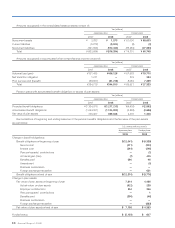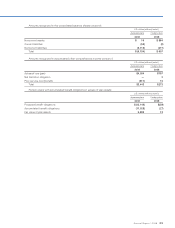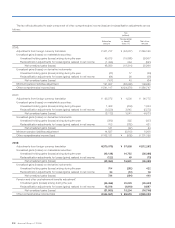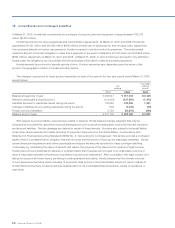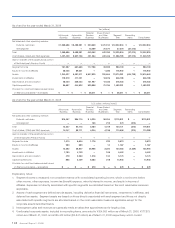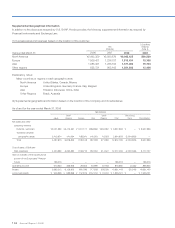Honda 2008 Annual Report Download - page 99
Download and view the complete annual report
Please find page 99 of the 2008 Honda annual report below. You can navigate through the pages in the report by either clicking on the pages listed below, or by using the keyword search tool below to find specific information within the annual report.
A n n u a l R e p o r t 2 0 0 8 9 7
17. Risk Management Activities and Derivative Financial Instruments
Honda is a party to derivative financial instruments in the normal course of business to reduce their exposure to fluctuations
in foreign exchange rates and interest rates. Currency swap agreements are used to convert long-term debt denominated
in a certain currency to long-term debt denominated in other currencies. Foreign currency forward exchange contracts and
purchased option contracts are normally used to hedge sale commitments denominated in foreign currencies (principally U.S.
dollars). Foreign currency written option contracts are entered into in combination with purchased option contracts to offset
premium amounts to be paid for purchased option contracts. Interest rate swap agreements are mainly used to convert
floating rate financing, such as commercial paper, to (normally three-five years) fixed rate financing in order to match financing
costs with income from finance receivables. These instruments involve, to varying degrees, elements of credit, exchange rate
and interest rate risks in excess of the amount recognized in the consolidated balance sheets.
The aforementioned instruments contain an element of risk in the event the counterparties are unable to meet the terms of
the agreements. However, Honda minimizes the risk exposure by limiting the counterparties to major international banks and
financial institutions meeting established credit guidelines. Management of Honda does not expect any counterparty to default
on its obligations and, therefore, does not expect to incur any losses due to counterparty default. Honda generally does not
require or place collateral for these financial instruments.
Foreign currency forward contracts and currency swap agreements are agreements to exchange different currencies at a
specified rate on a specific future date. Foreign currency option contracts are contracts that allow the holder of the option the
right but not the obligation to exchange different currencies at a specified rate on a specific future date.
Contract amounts outstanding for foreign currency forward exchange contracts, foreign currency option contracts and
currency swap agreements at March 31, 2007 and 2008 are as follows:
Yen
(millions)
U.S. dollars
(millions)
(note 2)
2007 2008 2008
Foreign currency forward exchange contracts ¥ 978,994 ¥ 615,845 $ 6,147
Foreign currency option contracts 5,793 272,204 2,717
Currency swap agreements 608,534 663,013 6,617
¥ 1,593,321 ¥ 1,551,062 $15,481
Cash flow hedge
The Company applies hedge accounting for certain foreign
currency forward exchange contracts related to forecasted
foreign currency transactions between the Company and
its subsidiaries. Changes in the fair value of derivative
financial instruments designated as cash flow hedges are
recognized in other comprehensive income (loss). The
amounts are reclassified into earnings in the same period
when forecasted hedged transactions affect earnings. The
amount recognized in accumulated other comprehensive
income (loss) was ¥20 million gain in the fiscal year ended
March 31, 2007 and ¥460 million ($5 million) gain in the
fiscal year ended March 31, 2008, respectively. All amounts
recorded in accumulated other comprehensive income
(loss) as year-end are expected to be recognized in earnings
within the next twelve months. The period that hedges the
changes in cash flows related to the risk of foreign currency
rate is at most around two months.
There are no derivative financial instruments where
hedge accounting has been discontinued due to the
forecasted transaction no longer being probable. The
Company excludes financial instruments’ time value
component from the assessment of hedge effectiveness,
of which amount was ¥1,187 million loss for the year ended
March 31, 2007, and ¥256 million ($3 million) loss for the year
ended March 31, 2008, respectively. There is no portion
of hedging instruments that has been assessed as hedge
ineffectiveness.
Derivative financial instruments not designated as
accounting hedges
Changes in the fair value of derivative financial instruments
not designated as accounting hedges are recognized in
earnings in the period of the change.
Interest rate swap agreements generally involve the
exchange of fixed and floating rate interest payment
obligations without the exchange of the underlying principal
amount.
At March 31, 2007 and 2008, the notional principal
amounts of interest rate swap agreements were ¥4,198,463
million and ¥4,294,956 million ($42,868 million), respectively.



